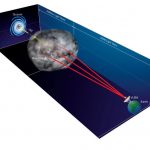Glossary of Radio Astronomy Terms
Radio Astronomy:
The science that deals with the study of the universe by means of radio waves.

Radio Galaxy:
A galaxy that emits radio waves from its central core. The energy to produce these emissions is generated by a supermassive black hole, which sends out massive jets of radio energy many millions of light-years into interstellar space.
Radio Source:
A point or small portion of the sky giving stronger radio emission than other parts of the sky surrounding it.
Radio Telescope:
Like an optical telescope, a radio telescopes receives, focuses, and analyzes light to form an image or study a celestial object. The longer wavelengths of radio waves mean that these telescopes use dish antennas to reflect and focus radio light, a receiving system to amplify and measure the signal, and a computer to process the data and develop an image.

Radio Waves:
Also known was electromagnetic waves or electromagnetic radiation, radio waves are the basic building blocks of radio communication and radio astronomy. They are created by transmitters which send the waves into space and detected by receivers which detect distant celestial objects.

Radio window:
The property of Earth’s atmosphere that allows certain wavelengths of electromagnetic radiation in the radio range to pass through.
Receiver:
An electronic device that amplifies, detects, and gives a measure of the intensity of radio signals.

Red Dwarf:
A cool, low mass star on the lower main sequence. (see main sequence for more)

Redshift:
The shift of all the spectral lines toward longer wavelengths due to the object moving further away as seen from the Earth. This recession, at great distances, is due to the overall expansion of the universe. (See spectral lines for more)

Resolution:
The ability of a telescope to show detail. One common way to describe the resolution of a telescope is to state the minimum angular separation at which a double star can be distinguished as two separate stars. (see double star for more)

Right ascension:
The equatorial coordinate that specifies the angle (usually specified in hours, minutes and seconds), which is measured eastward along the celestial equator from the vernal equinox to the hour circle passing through an object in the sky.
Red Giant:
A massive star with high luminosity and low surface temperature. Red giants are thought to be in a late stage of evolution when no hydrogen remains in the core to fuel nuclear fusion.

Resolving Power:
A telescope’s ability to sharpen images taken of different places in the universe.






